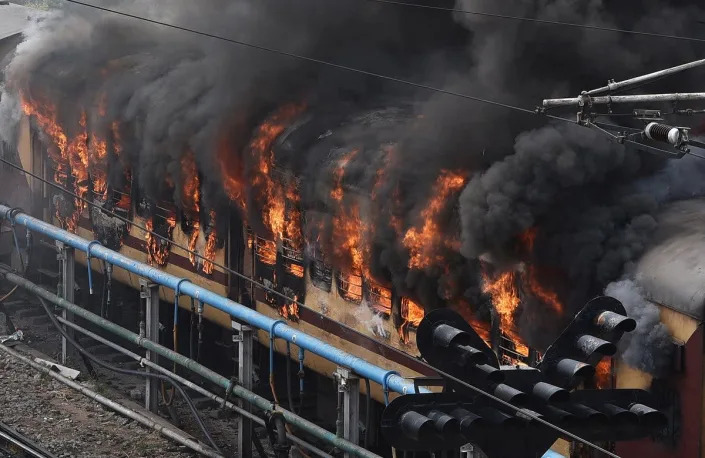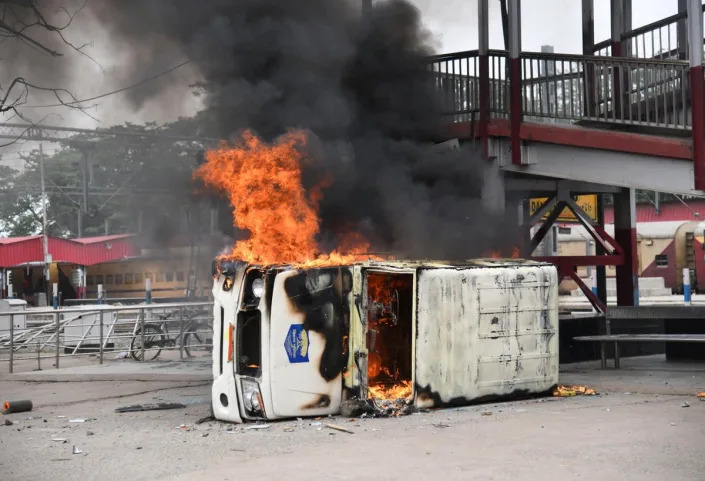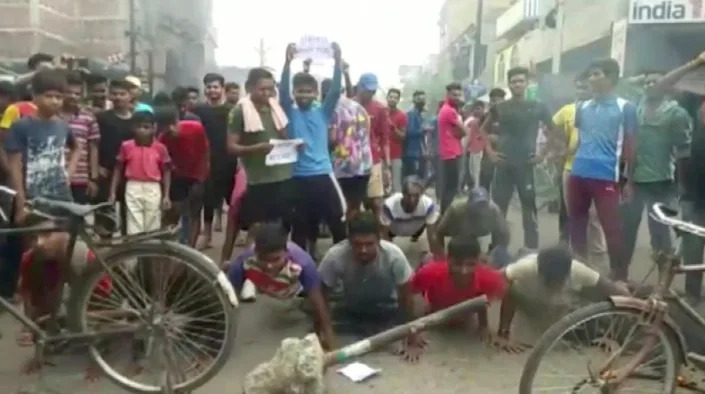Agnipath: One dead as trains set on fire across India amid protests against army reforms
Shweta Sharma
Fri, June 17, 2022
A protester died and several others were injured after police in India’s southern Telangana state allegedly opened fire on them as the country continued to witness anger over recent reforms announced in the recruitment process of the Indian armed forces.
Large scale nationwide protests continued to take place across India for the third consecutive day, leading to violence and trains being set on fire after protesters crowded railway stations.
Large crowds have taken over railway stations and blocked roads and highways in major Indian states, including Bihar, Uttar Pradesh, Telangana, Haryana, Rajasthan and national capital Delhi, demanding the government to reinstate the earlier recruitment process.
A train on a railway platform in Uttar Pradesh’s Ballia was set ablaze by a protesting crowd, causing damage to several coaches before police resorted to using force to disperse the crowd.
The situation escalated in Secunderabad when a violent mob ransacked railway platforms, vandalised computers and electronics, destroyed CCTV cameras, lights and set fire to 4-5 train engines and 2-3 coaches.

Police fired at least 10 rounds to control the situation, leaving at least 15 people injured. One of the protesters, identified as Damodar Kumar, succumbed to his injuries, reported the Indian Express.
Eight other injured protesters are receiving treatment at Gandhi Hospital while two remain at the railway hospital.
In the eastern state of Bihar, which is the worst hit by protests, at least two coaches in two different trains were set on fire in the Lakhisarai and Samastipur stations.
A mob outside the house of Bihar’s deputy chief minister Renu Devi attacked her residence and caused damage to property.
“Such type of violence is very dangerous for the society. The protesters should remember that this is a loss for the society,” Ms Devi, who was not at home at the time of the attack, told news channel NDTV.
Section 144, a prohibitory order used often by the government to ban gatherings of more than four people, was imposed in Haryana’s Gurugram, 20km away from the national capital, after a large number of people clashed with police.
On Friday, more than 200 train services were impacted, including 35 trains services cancelled and 13 terminated across the country, according to the Indian railways.
The ongoing demonstrations have forced the government to allow an exemption in the age limit just for this year by increasing the upper limit to 23 years from the existing 21.

Protesters, however, said they want the scheme to be rolled back as it would potentially leave them unemployed.
Defence minister Rajnath Singh, who unveiled the scheme on Tuesday, said the one-time waiver on the age relaxation “indicates that the Government cares for our youth”.
Under the new plan, referred to as the “Agnipath” programme, translates literally to “path of fire”.
Around 45,000-50,000 soldiers will be recruited annually among candidates aged between 17.5 years and 23 years.
Of the total annual recruits, only 25 per cent will be allowed to continue for another 15 years under a permanent commission, while others will be let off with skill certificates and bridge courses.
The contentious scheme has been harshly criticised by army veterans and aspirants for deploying a “hire and fire” culture into the armed forces as they say recruits will end up unemployed after a four-year stint.
The programme was announced despite existing anger as recruitments have been stalled for around two years due to the Covid pandemic, causing frustration among millions of aspirants fearing they might exceed the existing age limit.
The new scheme has not only shortened employment tenures to four years from the existing 17 for the lowest ranks, but has also made 75 per cent recruits ineligible for government pension.
Mr Singh claimed the scheme is needed to make the Indian armed forces battle ready and more youthful, by reducing the average age of personnel over time.
“Agnipath… is a truly transformative reform which will enhance the combat potential of the armed forces, with a younger profile and technologically adept soldiers,” he said.
Backlash grows to India’s plan to introduce US-style ‘tours of duty’ for military service
Shweta Sharma
Thu, June 16, 2022
Violent protests broke out in major Indian cities on Thursday, two days after the government announced a major overhaul to the recruitment process in the Indian armed forces.
Hundreds of young aspirants set train coaches on fire, blocked railway tracks and roads, and clashed with security forces as they raised slogans against the new US army-style short-term recruitment plan that they say will leave them unemployed.
The government of India on Tuesday unveiled the “Agnipath” or “Path of Fire” programme, which will induct aspirants for a short-term four-year contract into three services – navy, airforce and army. On completion of this programme, only 25 per cent will be retained and the others will be released.
Touted by defence minister Rajnath Singh as “major defence policy reform” to make the Indian armed forces more “battle-ready” and youthful, the move is aimed at cutting down ballooning pensions and salaries, which has been a long-pending issue for one of the world’s largest forces.
Demanding the rollback of the plan, a huge number of people hit the streets in the state of Bihar, Rajasthan, Haryana and Uttar Pradesh and raised slogans such as “down with the Indian government” and “give us jobs or kill us”.
Police resorted to baton charging and fired teargas to control the angry crowd.
However, several coaches of a train were set fire in Chhapra in Saran district of Bihar as protests intensified.
“The protesters set fire to a train bogie [coach] in one place,” said Sanjay Singh, additional director general of police in the eastern state of Bihar, adding that roads and railway tracks were obstructed in dozens of places.
Around 22 trains of East Central Railway in Bihar were cancelled and 29 others were affected due to demonstrations.
Under the new plan, around 45,000 to 50,000 soldiers will be recruited annually for candidates aged between 17.5 years and 21 years. Of the total annual recruits, only 25 per cent will be allowed to continue for another 15 years under permanent commission, while others will be let off with skill certificates and bridge courses.
The employment duration has been significantly reduced from up to 17 years for the lowest ranks.
Successful candidates will be given Rs 30,000 (£316) each month and other benefits during the four-year period. The short-term servicemen would get Rs 1,171,000 (£12,372) at the end of their contract.
The four-year-stint has effectively made 75 per cent of recruits ineligible for pension, which was one of the main benefits of joining the armed forces for hundreds of thousands of aspirants as it provided social security to those coming from marginalised backgrounds in absence of resources to get degrees for other career options.
The Indian army – one of the world’s biggest with 1.4 million personnel – was one of the main employers in the country. But frustration was already building up as the recruitment process had been frozen for the past two years due to the coronavirus pandemic and aspirants were worried about passing the age limit.
“Where will we go after working for only four years? We will be homeless after four years of service. So we have jammed the roads; the country’s leaders will now get to know that people are aware,” a protestor in Jehanabad, Bihar told Indian news agency ANI.
The new scheme has also triggered a debate among politicians and army veterans, many of whom say that lack of job security can lead to low motivation levels. Additionally, it poses the risk of having thousands of young unemployed youth with arms training in society, potentially causing a law-and-order fallout.
Major General GG Dwivedi in a column in The Indian Express dubbed the Tour of Duty model “tourist soldiering”, and said it is in vogue in the US and the west, where they have “peaceful neighbourhoods with settled borders”.

But the scheme is “flawed and merits a holistic review” as India faces the stark reality of a two-front threat on borders with hostile neighbours Pakistan and China, he said.
Retired Lieutenant General Zameer Uddin Shah said it is a “retrograde step” and “the most detrimental measure inflicted on armed forces”.
“With a year spent on training and six months on pre-release formalities, the soldier will get only 2.5 years to serve, which is inadequate to inculcate regimental ethos, affiliation, and discipline,” the veteran said.
Retired major general GD Bakshi said he was “flabbergasted” by the scheme.
“I thought initially it was a trial being done on a pilot basis. This is an across the board change to convert Indian armed forces to a short tenure quasi-conscript force like the Chinese. For God’s sake, please don’t do it,” he said in a tweet.
“Let’s not destroy our institutions in a time of great threats from China & Pak. Armed forces have performed well. Just for saving money let us not destroy what we have.”
No comments:
Post a Comment